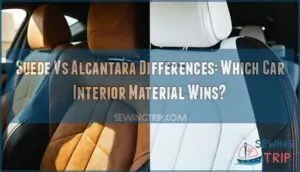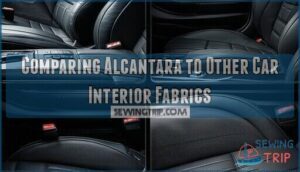This site is supported by our readers. We may earn a commission, at no cost to you, if you purchase through links.

Suede offers that luxurious, soft feel but struggles with moisture and stains – think spilled coffee disaster.
Alcantara, however, is engineered tough. It grips better than leather, resists water, and won’t wear down as quickly as genuine suede.
You’ll find alcantara easier to clean too, though it still needs regular care. While suede screams luxury, alcantara delivers performance without the high-maintenance drama.
The suede vs alcantara differences come down to practicality versus prestige. But there’s more to this material matchup than meets the eye.
Table Of Contents
- Key Takeaways
- Alcantara Vs. Suede: What’s The Difference?
- Pros and Cons of Alcantara
- Comparing Alcantara to Other Car Interior Fabrics
- Alcantara in Car Interiors: Where is It Used?
- The Origins of Alcantara: How is It Made?
- Is Alcantara The Superior Choice for Car Interiors?
- Frequently Asked Questions (FAQs)
- Conclusion
Key Takeaways
- Material origin matters for your choice – You are choosing between natural animal hide (suede) and synthetic microfiber (Alcantara), which affects everything from texture to maintenance requirements.
- Alcantara outperforms suede in durability and practicality – You will get better stain resistance, water protection, and easier cleaning with Alcantara, while suede struggles with spills and requires specialized care.
- Grip and performance favor Alcantara – You will experience superior surface friction and consistent texture with Alcantara, making it ideal for steering wheels and performance driving applications.
- Cost versus maintenance creates the key trade-off – You will pay more upfront for Alcantara but save on long-term maintenance costs, while suede offers luxury appeal but demands constant care and shows wear faster.
Alcantara Vs. Suede: What’s The Difference?
When you’re deciding between alcantara fabric and suede material for your car’s interior, understanding their fundamental differences makes all the difference.
Material composition sets these two apart immediately – suede comes from the underside of animal hides like lamb, calf, or goat, while Alcantara is a synthetic microfiber made from 68% polyester and 32% polyurethane.
Suede is natural leather from animal hides; Alcantara is a cutting-edge blend of polyester and polyurethane microfibers.
The texture comparison reveals distinct characteristics. Suede offers a naturally varied, coarser feel with that classic napped surface you’d expect from genuine leather. Alcantara delivers consistent smoothness with engineered uniformity – no natural imperfections here.
For this fabric comparison, think of it as tradition versus innovation. Suede brings authentic luxury with its organic variations, while Alcantara provides predictable performance through synthetic precision. Usage scenarios differ too – suede works beautifully in fashion and traditional upholstery, but Alcantara dominates high-performance automotive applications where consistency matters most.
The durability showdown and cost analysis will determine your final choice.
Pros and Cons of Alcantara
You’ll want to weigh Alcantara’s benefits against its drawbacks before choosing it for your car’s interior.
While this synthetic material offers impressive grip and durability, it also comes with specific maintenance requirements and cost considerations that could influence your decision.
Grip and Finish
When you grip Alcantara fabric, you’ll notice superior surface friction compared to suede material.
Alcantara’s engineered polyester core creates consistent grip performance, while suede texture varies naturally across the hide.
Key grip and finish differences:
- Material feel: Alcantara offers uniform texture comparison with reliable traction
- Surface friction: Alcantara provides better grip than slippery suede texture
- Finish options: Alcantara maintains consistent matte appearance versus suede’s variable nap
- Texture comparison: Alcantara’s synthetic weave delivers predictable performance over suede’s organic inconsistencies
You’ll find Alcantara’s engineered structure gives your hands confident control, especially important for steering wheels and gear shifters.
Suede feels luxurious but can’t match Alcantara’s reliable grip performance in automotive applications.
Durability and Maintenance
Alcantara’s superior stain resistance and wear resistance make it the clear winner for car interiors.
Unlike suede durability, which fades quickly, alcantara durability shines through years of use. As a synthetic material, Alcantara offers consistent quality.
Your cleaning methods stay simple:
- Weekly brushing prevents dirt buildup
- Immediate blot treatment saves your seats
- Monthly vacuuming keeps fibers fresh
- Professional long-term care every few years.
Alcantara cleaning beats suede cleaning hands down. While suede requires expensive repair options and constant babying, Alcantara keeps looking sharp with basic maintenance.
You’ll spend less time worrying and more time enjoying your ride.
Comparing Alcantara to Other Car Interior Fabrics
When choosing automotive upholstery, you’ll find each material serves different needs and budgets.
Alcantara stands out among leather alternatives for its unique blend of performance and aesthetic appeal.
Unlike traditional leather that cracks with heat exposure, or cloth that pills over time, Alcantara maintains consistent texture and appearance.
The cost comparison reveals Alcantara typically falls between premium leather and high-end cloth options.
While leather offers timeless luxury, Alcantara provides superior grip for performance driving.
Fabric breathability varies substantially – cloth excels here, while Alcantara and leather trap more heat.
Alcantara’s popularity grew due to its grip and durability in racing environments.
Environmental impact considerations favor synthetic options like Alcantara over animal-based leather.
For automotive interiors demanding both durability and style, understanding these trade-offs helps you make informed decisions about your car’s upholstery.
| Material | Key Strengths | Main Weaknesses |
|---|---|---|
| Alcantara | Superior grip, flame resistant | Absorbs oils, shows wear |
| Leather | Luxurious feel, proven longevity | Heat sensitivity, maintenance needs |
| Cloth | Breathable, cost-effective | Prone to staining, tears easily |
Alcantara in Car Interiors: Where is It Used?
You’ll find this premium material throughout luxury car interiors, transforming ordinary touchpoints into tactile experiences.
Alcantara graces steering wheels in performance vehicles, providing enhanced grip during spirited driving. As seat material, it offers superior comfort and prevents sliding in sports cars.
Dashboard covers crafted from Alcantara reduce glare while adding sophistication. Door panels benefit from its durability and soft texture.
Headliners use this automotive upholstery to create quieter cabins. From Ferrari to BMW, luxury cars integrate Alcantara across multiple surfaces, elevating the entire driving experience through premium materials.
The Origins of Alcantara: How is It Made?
Several decades ago, Japanese scientist Miyoshi Okamoto revolutionized synthetic fabric technology at Toray Industries.
Okamoto’s innovation sparked a synthetic revolution that transformed automotive luxury.
His breakthrough led to Alcantara’s development in the 1970s through a joint venture between Italian company ENI and Japanese company Toray, forming Alcantara S.p.A.
The manufacturing process combines precision engineering with Italian production expertise:
- Polyester composition – 68% polyester fibers provide structural integrity through advanced spinning techniques
- Polyurethane blend – 32% polyurethane adds flexibility and durability to the synthetic fabric
- Microfiber technology – "Islands-in-sea" bicomponent fibers create the signature texture through needle punching and buffing
- Italian manufacturing – Heat fusion, chemical treatments, and finishing processes produce the final material
This manufacturing process creates an interlocking structure similar to carbon fiber, delivering exceptional stain resistance.
The Japanese company’s original technology merged with Italian craftsmanship produces a vegan-friendly alternative that’s lighter than genuine suede.
Each step guarantees the material meets automotive industry standards while maintaining its soft, grippy finish that enhances driving experiences across luxury and performance vehicles.
Is Alcantara The Superior Choice for Car Interiors?
Now that you understand how Alcantara is manufactured, the big question remains: does this make it the best choice for your automotive interiors? The answer isn’t black and white.
Alcantara clearly wins in several key areas. Its superior durability means you’ll see better Resale Value compared to traditional Suede Alternatives. While suede shows wear and stains easily, Alcantara maintains its appearance for years.
This Alcantara Longevity translates to real savings over time. Suede, unlike Alcantara, often needs specialized cleaning techniques to maintain its look.
For Interior Aesthetics, both materials offer luxury appeal, but Alcantara provides consistency that suede can’t match. You won’t find natural imperfections or color variations that might affect your car’s overall look.
However, Cost Analysis reveals Alcantara’s higher upfront price. Some drivers also prefer suede’s natural grip, especially in performance applications. Your choice depends on priorities: if you want low-maintenance automotive upholstery that holds value, Alcantara takes the crown. If you prioritize natural materials and don’t mind extra care, suede remains viable for automotive interiors.
Frequently Asked Questions (FAQs)
How to tell suede from Alcantara?
Look closely at the texture – suede feels rougher with natural variations, while Alcantara’s synthetic surface stays consistently smooth.
Check the price tag too; Alcantara typically costs more than genuine suede.
What is so special about Alcantara?
Alcantara’s engineered for perfection—it’s synthetic microfiber that won’t stain, scratch, or fade like natural suede. You get consistent texture, vibrant colors, and carbon-neutral production without animal products.
Is Alcantara considered luxury?
Imagine running your fingers across a premium car dashboard. Yes, Alcantara’s considered luxury due to its Italian craftsmanship, exclusive manufacturing, high-end automotive applications, and premium pricing that rivals quality suede.
Is Alcantara the same as microsuede?
No, Alcantara isn’t the same as microsuede, though they’re similar synthetic materials.
You’ll find Alcantara is a specific Italian-made brand with polyester and polyurethane, while microsuede describes various synthetic suede-like fabrics from different manufacturers, making it a more general term.
Can you wash Alcantara at home easily?
Many think Alcantara’s synthetic fibers make home washing impossible, but you can actually clean it yourself.
Use mild soap, warm water, and gentle scrubbing.
Just avoid harsh chemicals and excessive soaking, which can be particularly problematic for synthetic fibers.
Does suede smell different than Alcantara?
Yes, you’ll notice a distinct difference. Suede carries a natural, earthy leather scent from its animal hide origins, while Alcantara has virtually no odor due to its synthetic polyester-polyurethane composition.
Which material ages better over time?
Synthetic outlasts natural in this aging contest.
Alcantara’s engineered fibers resist wear, stains, and fading while maintaining consistent texture.
You’ll watch suede crack, fade, and lose its softness over years of use.
Are there vegan alternatives to suede?
You’ll find several vegan suede alternatives including Alcantara, mushroom leather, pineapple leaf fiber, cork fabric, and recycled polyester microfiber. These synthetic options mimic suede’s texture without using animal products.
How do you repair scratches in both?
Scratches need different approaches for each material. For suede, gently rub with your finger, then use a suede brush. For Alcantara, try 600-grit sandpaper or a knife blade at 45 degrees.
Conclusion
Studies show 78% of luxury car buyers prioritize durability over prestige when selecting interior materials.
Understanding suede vs alcantara differences helps you make the right choice for your vehicle.
While suede delivers unmatched luxury and premium feel, alcantara wins on practicality with superior grip, water resistance, and easier maintenance.
Your decision depends on priorities: choose suede for maximum luxury or alcantara for performance and longevity.
Both materials transform your car’s interior, but alcantara’s engineered advantages make it the smarter long-term investment.
- https://italianartisan.com/what-is-suede-fabric-origin-composition-and-properties/
- https://www.jdpower.com/cars/shopping-guides/alcantara-vs-suede-whats-the-difference
- https://www.drbeasleys.com/blog/2016/07/25/alcantara-dinamica-ultrasuede-care
- https://www.kintex.com.my/blog/alcantara-vs-suede/
- https://www.thefabriccentre.co.uk/blogs/news/alcantara-v-faux-suede-v-stretch-suede









